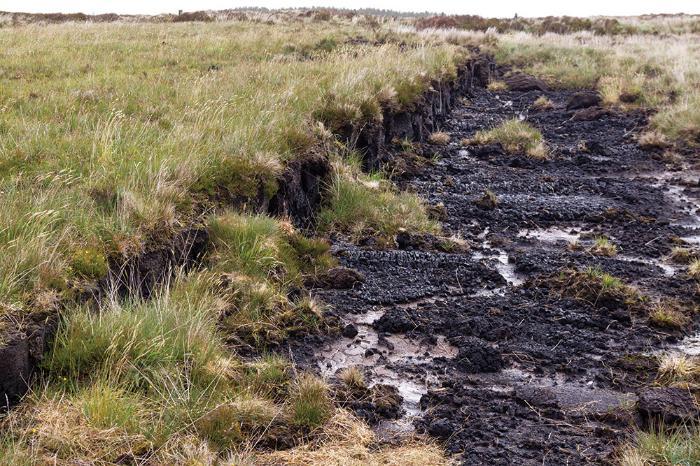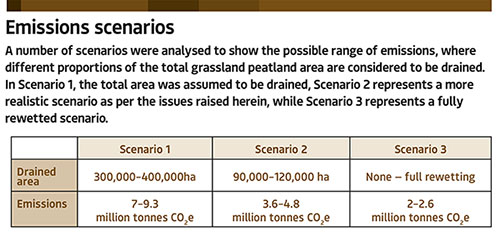19 March 2024
Worth re-peat-ing

Peatlands are a particularly effective soil type for carbon storage. Assessing their drainage status can help harness their potential towards emissions reductions.
Peatlands form where high rainfall or impeded drainage causes waterlogging, restricting oxygen supply and suppressing decomposition of organic matter. Given the accumulation of vast amounts of organic material, peatlands offer significant value in terms of carbon (C) storage.
Peatlands cover only 3% of the Earth’s land surface but store about 15-30% of the world’s soil C as peat. In Ireland, peat soils cover approximately 1.46 million ha or 21% of the land surface and store approximately 2.3 billion tonnes of C.
Over many generations, drainage of these peatlands was actively encouraged and incentivised with a focus on maximising the peat resource in terms of energy production, horticulture and agriculture. It is estimated that 335,000ha of peat soils are under grassland today.
At present, as no information has been available on their drainage status, all of these soils are assumed to be artificially drained within national emission inventory reporting and are therefore responsible for significant emissions of 8–9 million tonnes CO2-equivalent annually.
Raising the water table
The water table is the upper level of an underground surface below which the soil is saturated with water. The depth of the water table within the peat is the key factor that controls whether accumulation or decomposition of organic matter is the dominant process. Consequently, the long-term stability of peat is very sensitive to any changes brought about by drainage, explains Pat Tuohy, a Senior Research Officer at Teagasc Moorepark.
“When drained effectively, aerobic conditions mineralise C stored in the peat; greenhouse gases (GHG) such as carbon dioxide and nitrous oxide are then released to the atmosphere. This process transforms peatlands from C-sinks into C-sources. Characterising the water table behaviour and — where possible — controlling the water table is the major lever at our disposal in managing C storage on these soils. Water table management — or rewetting — is defined as raising the water table in soils that had previously been drained. This can be done by reducing water losses from the site by decreasing surface drainage, surface runoff, sub-surface seepage or groundwater extraction.”
Substantial cuts in GHG emissions are required in line with international agreements to reduce climate change and its impacts. The land-use sector therefore needs targeted changes in management such that C sources are minimised and sinks promoted on a local and global scale. Management of grassland peat soils at farm scale will require a knowledge of the distribution of peat soils and their drainage status.
However, the drainage status of such soils is extremely complex. This creates problems when trying to account for drained and undrained areas at national scale, where estimates can tend towards an “all or nothing” approach with little room for subtlety, explains Pat. “Currently, using national statistics in a Tier 1 approach (default emission factors), all of the 335,000ha of the grassland peat soils are assumed to be drained for the purposes of National Inventory Reporting. This assumption has not been justified, and such crude estimates make it difficult to form clear policy in supporting GHG emissions reductions.”

Drain strain
Land drainage works typically comprise a network of open drains — running at a relatively low intensity — acting as an outlet from an in-field drainage system, itself comprising sub-surface pipes installed at relatively high intensity. While most of the managed grassland on peat in Ireland would have been subjected to the installation of open drains, in-field drainage would have been less common.
In many cases, effective field drainage is economically infeasible. It must be remembered that effective lowering of the water table over wide areas is unlikely where only open drains are installed, and intensive in-field drainage is required to achieve water table control in peat soils. In addition, different peatland types require different drainage system designs and all drainage systems have a limited lifespan, requiring regular repair and replacement to retain long-term functionality.
Pat adds: “Such insights challenge the assumption that peat soils are uniformly and optimally drained and maintained over time and calls into question the existing assumptions of drainage status of peat soils, their associated emissions and our impression of what does and does not need water table management. Quantifying these aspects will establish a starting point for restoration efforts.”
Reassessing emissions
The total emissions from grasslands on peat soils are overestimated due mainly to the imposition of a simplistic assumption with regard to drainage status. As such, while large areas of peatland have been transformed from their natural state to grassland agriculture, there is no evidence to support that effective drainage ever occurred on much land assumed — for the purposes of GHG estimates — to have been drained. Therefore, a refinement of the GHG emissions associated with this land use is required. A number of other factors currently being investigated, such as peatland extent, land use, nutrient status and associated emissions factors, are all subject to refinement over time. A significant research focus on these areas is ongoing.
To harness the potential of peat soils and the scope for rewetting as a climate change mitigation tool, alternative estimations of the assumed emissions are put forward. The application of these findings can impact significantly on estimated emissions from grassland peat soils and more broadly on the land use, land use change and forestry sector, while offering clarity regarding future policy and management of these soils.
Emissions scenarios
A number of scenarios were analysed to show the possible range of emissions, where different proportions of the total grassland peatland area are considered to be drained. In Scenario 1, the total area was assumed to be drained, Scenario 2 represents a more realistic scenario as per the issues raised herein, while Scenario 3 represents a fully rewetted scenario.
Read more TResearch Articles here
Contributors
Pat Tuohy, Senior Research Officer, Animal & Grassland Research and Innovation Centre, Teagasc Moorepark. patrick.tuohy@teagasc.ie
Lilian O’ Sullivan, Senior Research Officer, Teagasc, Environment Research Centre, Teagasc Johnstown Castle.
Conor Bracken, Research Officer, Environment Research Centre, Teagasc Johnstown Castle.
Owen Fenton, Principal Research Officer, Environment Research Centre,Teagasc Johnstown Castle.
Photo credit: w-ings/istock.com
